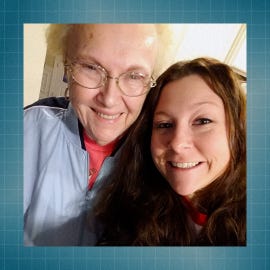Eldercare is Expensive and Emotionally Taxing for Families
This story is part of Priced Out, CNET’s coverage of how real people are coping with the high cost of living in the US.
As a child, I was spoiled by my grandparents, who would extend their wallets on new toys or clothes whenever I asked. At the time, I had little concern for the dollars spent on my shiny “win” of the day.
Brandon Douglas/CNET
Fast-forward 30 years, and our relationship now revolves around those dollars. Caring for my aging grandparents is sending my family’s hard-earned savings out the door.
The high price of eldercare in the United States often falls on the shoulders of families, who struggle between making ends meet and enlisting the best care for their aging relatives. My own family’s situation in a suburb of Charlotte, North Carolina, is just one of many stories in a country where a growing aging population faces similar financial struggles.
By 2034, Baby Boomers born between 1946 and 1964 are expected to outnumber the younger population for the first time in US Census history. All the while, the cost of long-term care — from nursing homes and daycare services to supplies and medication — continues to surge, placing an increasing strain on American households.
As we approach this generational shift, there’s a critical need for greater access to resources that will lower long-term care costs and for increased services for those 65 and older. Figuring out a plan ahead of time with your family can help make eldercare for your loved ones more affordable.
A complex game of musical caretakers

Melinda Skutnick and her grandmother
Melinda Skutnick and her grandmother
Nearly a decade ago, my family took steps to prepare for the inevitability of assisting my maternal grandparents, now 87 and 82, as they aged. We relocated them from Pennsylvania to North Carolina, where my parents and I also live. The sale of my grandparents’ home helped fund a portion of their move and secured them furniture and a new car. But the money wasn’t enough to purchase a new place for them to live.
That cost landed on my mother and uncle, who spent $100,000 in 2013 to buy my grandparents a house. That was the first major expense. In the years that followed, we’ve provided miscellaneous financial support, from weekly groceries and supplies to home maintenance, like house painting, carpet shampooing, roof repairs and lawn care. Dollars here and there.
My grandparents receive about $1,700 combined per month in Social Security income and currently have around $25,000 in savings. Both are on Medicare, which offers health insurance to those who receive Social Security and who are 65 and older, but does not cover long-term care like assisted living, nursing homes and supplementary support services. They’ve applied for Medicaid, which provides health insurance to low-income individuals as well as vital support to older adults in need of care, but that approval is still pending.
As their health has worsened, so have our expenses — with no end in sight.

Melinda Skutnick and her grandfather
Melinda Skutnick and her grandfather
In the fall, my grandfather broke his hip and needed surgery. We were relieved that the operation went well, but he now needs constant care at an expensive in-patient rehab facility. Since his insurance ended financial assistance last month, it costs $362 per day for his continued stay and therapy to help him recover. If we were to put every penny of my grandparents’ savings toward care for my grandfather, it would cover 69 days at the facility. Then the bill becomes my family’s obligation.
Traveling to doctors’ appointments or sitting with my grandmother, who requires round-the-clock care for her dementia, has also meant forgoing work and income for myself and other family members. This past year, for example, I lost out on a long-term writing project for $3,000 a month because the employer was worried about it conflicting with my time commitment to my grandparents’ health. As a full-time freelance writer, it was a huge hit to my budget, but I didn’t have a choice.
A caretaker, at the cost of $100 per week, offers a brief reprieve each Monday to allow me a few hours of uninterrupted work. Meanwhile, just about all their other necessities have gone up in price: utilities, food and even her Depend diapers.
High eldercare costs affect millions of households

Marge Wolfe and her late mother
Courtesy of Marge Wolfe
My family is still at the start of our eldercare journey. Millions of other families across the country have spent years and even decades caring for their aging loved ones. Two of those families are in my own community of Mooresville, just outside of Charlotte.
Marge Wolfe cared for her mother, who was also named Marge, from 2005 until her death from Alzheimer’s disease last summer. It was a full 17 years that included in-home hospice care and supplies. Between lost wages and paying for her mother’s medical expenses out of pocket, Wolfe spent about $30,000, depleting the entirety of her retirement savings.
Wolfe eventually had to take out a second mortgage on her house to make sure she could cover her mother’s Alzheimer’s medications, which cost $600 a month. Tacked onto that were adult diapers at $100 per month, four uses of mobile transport to doctor’s appointments at $150 each and washable bed liners at $300.
“I was pretty much living paycheck to paycheck,” Wolfe said.
As Wolfe’s mother’s illness got worse, she needed in-home hospice. At that time, Medicare supplied the wheelchair, bedside commode, tray table and hospital bed as well as a caretaker two times a week and a weekly nurse. But then Wolfe’s mom plateaued. She wasn’t getting worse, but also wasn’t improving. Medicare discharged her from hospice and removed her medical supplies, leaving Wolfe to take on the expense of replacing these items out of pocket.
Wolfe’s mom remained out of hospice care for the next two years, but then returned to it three additional times before she died in the summer.
Jamie Neese has been caring for his 75-year-old mother-in-law, Fay, and Fay’s 68-year-old younger sister, Sue, in his immediate family’s home for over five years. Sue was diagnosed with cerebral palsy as a child, and Fay had been her caretaker for most of her life. But then Fay, who also has polio, COPD and other illnesses, experienced a sharp health decline and was also diagnosed with ulcerative colitis. Now, Fay requires daily care.
Neese had prepared for the pair to move into his family’s home, spending $150,000 to add a 600-square-foot two-bedroom wing to the house. He has taken on the role of full-time caretaker for both Fay and Sue and no longer works. He researched options for an outside caregiver so he could return to work, but the math wasn’t adding up for his family. His entire paycheck would go toward paying for their care.
Though Fay and her sister receive $1,200 a month from disability benefits, Neese said it is “barely enough to eat on.” He and his family spend $625 a month just for food that adheres to their dietary restrictions, plus $600 for adult diapers, wipes and ointments, and $135 for vitamins. Plus, there are doctors’ appointments, each with a $15 to $45 co-pay and a $500 monthly cost for transportation. The family also bought a $1,500 stretcher to accommodate Fay’s transport limitations.
The expenses are felt throughout the Neese home.
“We have cut back on everything. We haven’t taken any vacations in three years. We haven’t gone out to eat much,” he said.
Resources for families struggling with eldercare expenses
Across the US, there’s a 70% chance that someone over 65 will need long-term care services in their remaining years, according to LongTermCare.gov, and 20% of today’s 65-year-olds will require it for more than five years.
The first step is to make sure your aging relatives have some kind of coverage, either through Medicare or Medicaid, and that they don’t lose it. The AARP offers an extensive resource list on where to find help with Medicaid and Medicare questions, including online, phone, in-person and printed resources. As your relatives approach retirement age, it’s worth looking into long-term care insurance. The AARP recommends buying a policy between the ages of 60 and 65 to help cover future care expenses.

Debra Feldman
Courtesy of Debra Feldman
The next step is to plan ahead and anticipate the expenses.
“I’ve seen children where they’ve supported their parents to the point where they have no savings left,” said Debra Feldman, president of the board of directors for Aging Life Care Association, a nonprofit dedicated to supporting care managers.
It’s especially true when looking at facility care. “Costs are kind of through the roof, in particular, since the pandemic,” Feldman said.
Nationally, the median rates for room and board vary by market and level of service. Assisted living communities, per the American Health Care Association and National Center for Assisted Living, average $51,600 per year, with nursing homes reaching six digits: $93,075 for a semi-private space and $105,850 for a private room. Those prices are simply out of reach for most households, which is when Medicaid comes in. Nearly one in six assisted-living residents rely on Medicaid to pay for daily services, according to the American Health Care Association.
Feldman suggests families prepare documents such as a will and power-of-attorney. She also advocates working with a wealth adviser to start figuring out how aging parents or grandparents can make the most of the assets they already have. Families can also pursue things like tapping into reverse mortgages, selling their life insurance policies and working with an aging life care manager to discuss long-term care plans, according to Feldman.
Households struggling to pay for their eldercare bills have some other resources to explore. Individuals can find support by connecting with others in the same situation to share ideas, tips and recommendations. Online forums like AgingCare.com and Facebook groups are full of advice for seniors and their families.
Additional resources include A Place for Mom, a website that helps connect seniors and their families to affordable resources. Keep in mind, some of these resources may only be available at a cost, depending on the services you need.
To save a few dollars, look for local organizations that assist your area’s older residents. Here in Mooresville, North Carolina, our county’s Iredell Council on Aging has proven immensely valuable for information and small-scale services, such as supplementary in-home caretaker relief as well as a chores program that helped my grandparents. The US Administration for Aging offers an Eldercare Locator, which can also help you find services and resources for seniors in your area.
For all the latest world News Click Here

